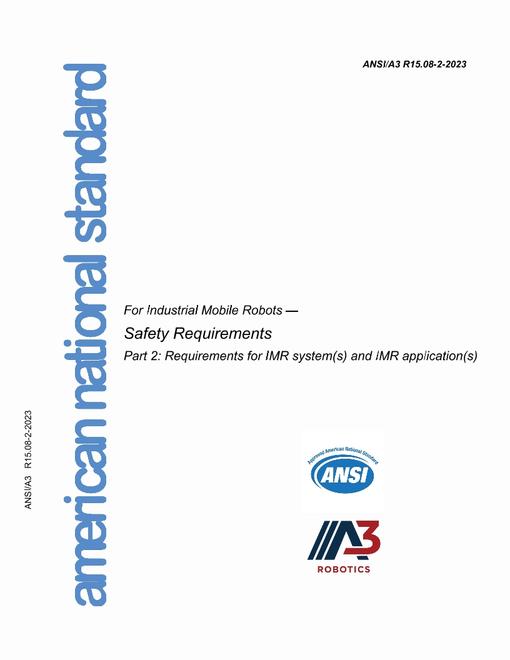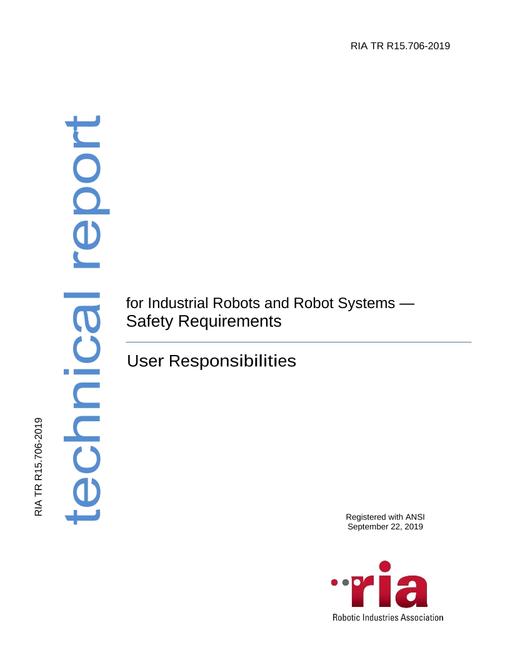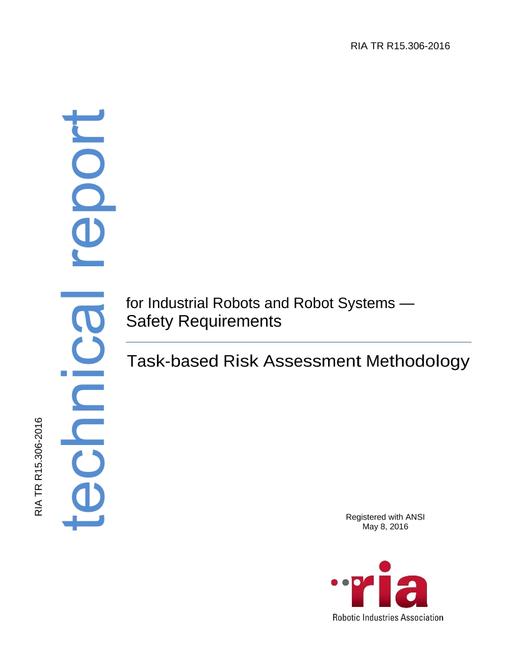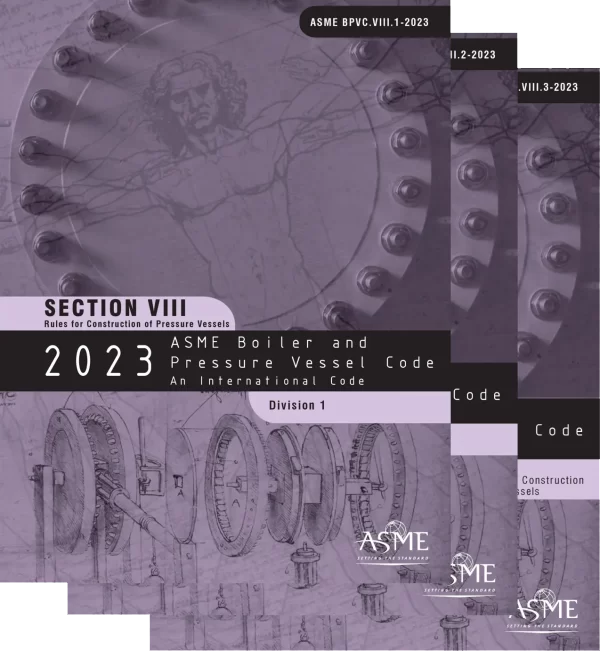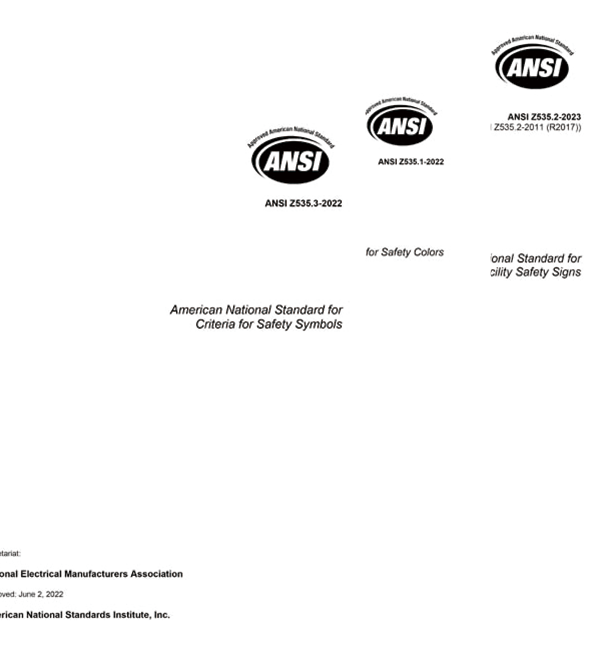RIA-A3 R15.08-2-2023
2023
Industrial Mobile Robots – Safety Requirements – Part 2: Requirements For IMR System(S) And IMR Application(S)
- Format:
- Language(s) :
- Published :
- English
- 07/18/2023
This document specifies safety requirements for industrial mobile robot systems (IMR systems) and IMR applications, described as follows in Part 1:
— IMR Type A: AMR without any attachments. Such platforms consist of the mobile platform, alone, and are typically intended to be used as the basis for an IMR Type B or C.
— IMR Type B: AMR with either passive or active attachments, excluding manipulators. Such active attachments can include roller tables, conveyors, and linear lift devices (e.g., picking attachments).
— IMR Type C: IMR constructed from an AMR or an AGV as a mobile platform with a manipulator as the attachment.
For the purposes of this document, “industrial” pertains to the production of goods and related services and environments, including but not limited to manufacturing, laboratory, pharmaceutical, warehousing, distribution, logistics, and other workplaces not traditionally considered strictly “industrial”. This document is intended to provide guidance regarding applications primarily for use in structured and semi-structured industrial environments where the individuals interacting with the system have been trained in the safe interaction with the IMR system. See Part 3 for additional information on training (to be published separately).
IMR system integration includes the following:
a) the addition of equipment to an IMR within the limits described in 5.2.3.2;
NOTE 1: According to ANSI/RIA R15.08-1, conversion of an IMR Type A to Type B or C, through the addition of attachments or manipulators, is considered to be manufacturing the Type B or C IMR; it is a stage that occurs prior to integration of the IMR system. IMR system integration begins with one or more complete IMR unit(s) (of Type B or C) and adds equipment to the IMR and/or the deployed operating environment if needed for the application.
b) the design, deployment, operation, maintenance and decommissioning of industrial mobile robots and systems in a deployed operating environment;
c) the design, deployment, operation, and maintenance of interfaces between industrial mobile robots and other equipment; and
d) creation of information regarding the design, deployment, operation, maintenance and decommissioning of industrial mobile robot systems.
When combining one or more IMRs and other related equipment into an IMR system in the deployed operating environment, IMR manufacturers are also acting as integrators.
For the purposes of this document, “mobile” refers to ground-based systems that can navigate and traverse a horizontal surface or series of horizontal surfaces (e.g., steps or stairs) within their deployed operating environment.
The following robot systems are out of scope of this document:
— airborne,
— waterborne,
— those permanently mounted on rails or gantries,
— mobile platforms that are solely manually controlled (e.g., human remote control, human continuous local control), and
— non-industrial mobile robots.
NOTE 2: Safety requirements for non-industrial mobile robots can be found in other standards (e.g., ISO 13482).
NOTE 3: Examples of non-industrial AMR applications include: AMRs intended for consumer or household use; undersea, military and space robots; or medical, surgical, or rehabilitative mobile robots.
NOTE 4: IMRs that “climb” shelves or other infrastructure elements can be addressed by this document where the risk assessment considers risks due to falling equipment, components, and payloads.
NOTE 5: For automated storage and retrieval systems, see ASME B30.13 and EN 528.
This document addresses hazards commonly associated with IMRs and IMR systems. However, the hazards associated with a particular IMR system can be unique. Therefore, risk assessment is required to identify the task(s) and operation specific hazards and associated risks.
The IMR system can itself be part of a larger system; that is, the IMR system can interact with other system(s) and machinery as part of an integrated machinery system (IMS). Requirements for such other machinery or systems separate from the IMR system (e.g., muting, blanking, restarting such other machinery or systems) is out of scope for this document; see ISO 11161 or ANSI B11.20 for more information on safety requirements for an IMS.
| RIA-A3 R15.08-2-2023 | |
|---|---|
| STANDARD INFO: | |
| Standard Name | RIA-A3 R15.08-2-2023 |
| Scope | Industrial Mobile Robots - Safety Requirements - Part 2: Requirements For IMR System(S) And IMR Application(S) |
| Publisher | A3 - A3, Association For Advancing Automation |
| Languages | English |
| State | |
| Publication Year | 2023 |
| Most recent Version | MOST RECENT |
| Whether to be replaced | |
| Addendum | |
| FILE INFO: | |
| ANSI | ANSI Approved |
| File Size | 1 file , 2.5 MB |
| ISBN(s) | 9798218279394 |
| Number of Pages | 142 |
| Published | 07/18/2023 |
| RIA-A3 R15.08-2-2023 | ||
|---|---|---|
| History | Publisher Year | |
Related products
- Format:
- Language(s) :
- Published :
- English
- 09/22/2019
$25
- Format:
- Language(s) :
- Published :
- English
- 05/08/2016
$22

Over 3,000,000 global standards
Our standards library is extensive, with over 2 million documents, ensuring we meet the needs of various industries. Whether it’s ASME, DIN, ASTM or ISO and other internationally recognized standards, we offer complete documents and the latest versions to help customers adhere to industry regulations in their projects. Whether your needs are technical standards, regulatory requirements, or design guidelines, our standards library provides comprehensive support.
24 online customer service
Our team includes up to 50 engineers from fields such as healthcare, electronics, and construction, who can answer your technical questions and ensure you find the correct and accurate standard documents. We are dedicated to helping you find the best solution that meets your needs.

Thanks to the StandardsClub customer service team for helping me find the ASME BPVC-2023 SET I was looking for in a high-quality PDF version. Their assistance was excellent, and the document quality exceeded my expectations!
This standard document is very detailed, covering all relevant technical points, and provides comprehensive guidance for my project. The ANSI/NEMA Z535 SET was exactly what I needed, and I am very satisfied with the quality!
The purchasing process was straightforward, the price was very competitive, and the download was quick. The Tissue Engineering Standards Addressing Product Quality and Characterization Package was of excellent quality and provided all the information I needed. Definitely a great value for the price!
“Got questions? Our professional customer service is ready to assist you anytime. Whether it’s finding documents, getting discounts, or navigating the purchase process, let us help you get the standards you need!”

Sign Up Our Newsletter
Don’t miss out! Subscribe now to get exclusive offers and industry insights!
We care about your data in ou privacy policy.

